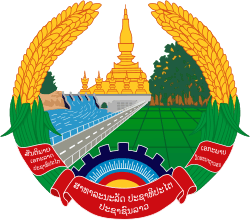Demographics of Laos
This article is about the demographic features of the population of Laos, including population density, ethnicity, education level, health of the populace, economic status, religious affiliations and other aspects of the population.
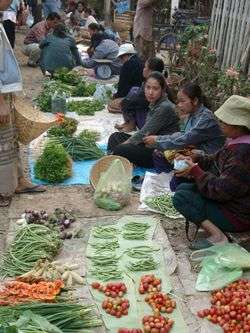
Laos' population was estimated at about 7.06 million in 2018, dispersed unevenly across the country. Most people live in valleys of the Mekong River and its tributaries. Vientiane Prefecture, which includes Vientiane, the capital and largest city of the country, had about 569,000 residents in 1999. The country's population density is 23.4/km2.
In March 2005, the total population was 5.62 million (2.82 million females, 2.80 million males) in the 2005 census, an increase of 1.047 million since the previous 1995 census.[1]
Overview
The demographic makeup of the population is uncertain as the government divides the people into three groups according to the altitude at which they live, rather than according to ethnic origin. The lowland Lao (Lao Loum) account for 68%, upland Lao (Lao Theung) for 22%, and the highland Lao (Lao Soung, including the Hmong and the Yao) for 9%.
Ethnic Lao, the principal lowland inhabitants and politically and culturally dominant group, make up the bulk of the Lao Loum and around 60% of the total population. The Lao are a branch of the Tai people who began migrating southward from China in the first millennium A.D. In the north, there are mountain tribes of Miao–Yao, Austro-Asiatic, Tibeto-Burman Hmong, Yao, Akha, and Lahu who migrated into the region in the 19th century. Collectively, they are known as Lao Sung or highland Lao.
In the central and southern mountains, Mon–Khmer tribes known as Lao Theung or upland Lao, predominate. Some Chinese minorities remain, particularly in the towns, but many Laotian Chinese were forced to leave during 1975-80 when Laos followed the anti-Chinese policy of Vietnam.
The predominant religion is Theravada Buddhism. Animism is common among the mountain tribes. Buddhism and spirit worship coexist easily. There is a small number of Christians and Muslims.
The official and dominant language is Lao, a tonal language of the Tai linguistic group. Midslope and highland Lao speak tribal languages. French, once common in government and commerce, has declined in use, while knowledge of English — the language of the Association of Southeast Asian Nations (ASEAN) — has increased in recent years.
With a median age of 19.3, Laos has the youngest population of Asia.
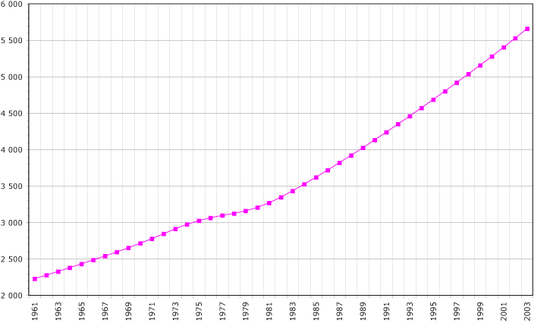
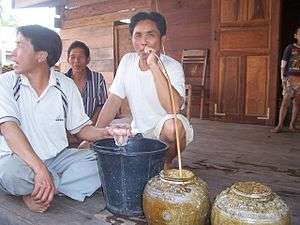
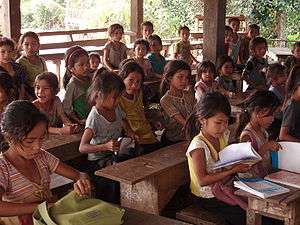
Population
According to the 2019 revision of the World Population Prospects[2][3], the population of Laos increased from 1.7 million in 1950 to 7.1 million in 2018. Until the year 2000 the proportion of children 0–14 years of age was over 40% of the total population. Due to decreasing fertility rates this proportion decreased to 34.5% in 2010. The proportion of elderly people is still very low (3.9%), although the proportion doubled between 1950 and 2010.
| Total population | Population aged 0–14 (%) |
Population aged 15–64 (%) |
Population aged 65+ (%) | |
|---|---|---|---|---|
| 1950 | 1,683 | 40.4 | 57.4 | 2.1 |
| 1955 | 1,897 | 41.4 | 56.2 | 2.4 |
| 1960 | 2,130 | 42.1 | 55.3 | 2.6 |
| 1965 | 2,391 | 42.2 | 54.9 | 2.9 |
| 1970 | 2 691 | 41.9 | 55.0 | 3.1 |
| 1975 | 3,042 | 42.1 | 54.7 | 3.2 |
| 1980 | 3,235 | 43.9 | 52.5 | 3.5 |
| 1985 | 3,648 | 44.0 | 52.4 | 3.6 |
| 1990 | 4,192 | 43.7 | 52.7 | 3.6 |
| 1995 | 4,795 | 43.6 | 52.8 | 3.6 |
| 2000 | 5,317 | 42.3 | 54.0 | 3.7 |
| 2005 | 5,753 | 39.1 | 57.1 | 3.8 |
| 2010 | 6,201 | 34.5 | 61.6 | 3.9 |
Structure of the population
Structure of the population (March 2005; census):[4]
| Age group | Male | Female | Total | % |
|---|---|---|---|---|
| Total | 2 800 551 | 2 821 431 | 5 621 982 | 100 |
| 0-4 | 351 559 | 349 356 | 700 915 | 12,47 |
| 5-9 | 379 137 | 370 071 | 749 208 | 13,33 |
| 10-14 | 391 785 | 375 371 | 767 156 | 13,65 |
| 15-19 | 323 729 | 323 540 | 647 269 | 11,51 |
| 20-24 | 253 926 | 261 371 | 515 297 | 9,17 |
| 25-29 | 211 279 | 218 330 | 429 609 | 7,64 |
| 30-34 | 176 515 | 183 480 | 359 995 | 6,40 |
| 35-39 | 164 415 | 165 362 | 329 777 | 5,87 |
| 40-44 | 132 335 | 133 532 | 265 867 | 4,73 |
| 45-49 | 113 869 | 113 298 | 227 167 | 4,04 |
| 50-54 | 86 770 | 91 210 | 177 980 | 3,17 |
| 55-59 | 62 691 | 65 640 | 128 331 | 2,28 |
| 60-64 | 50 006 | 55 008 | 105 014 | 1,87 |
| 65-69 | 38 289 | 41 251 | 79 540 | 1,41 |
| 70-74 | 27 652 | 31 927 | 59 579 | 1,06 |
| 75-79 | 17 964 | 19 208 | 37 172 | 0,66 |
| 80-84 | 10 402 | 12 180 | 22 582 | 0,40 |
| 85-89 | 4 631 | 5 697 | 10 328 | 0,18 |
| 90-94 | 1 964 | 2 781 | 4 745 | 0,08 |
| 95-99 | 982 | 1 393 | 2 375 | 0,04 |
| 100+ | 480 | 936 | 1 416 | 0,03 |
| unknown | 171 | 489 | 660 | 0,01 |
| Age group | Male | Female | Total | Percent |
|---|---|---|---|---|
| 0-14 | 1 122 481 | 1 094 798 | 2 217 279 | 39,44 |
| 15-64 | 1 575 535 | 1 610 771 | 3 186 306 | 56,68 |
| 65+ | 102 364 | 115 373 | 217 737 | 3,87 |
Structure of the population (01.03.2015) (Census) :
| Age group | Male | Female | Total | % |
|---|---|---|---|---|
| Total | 3 254 770 | 3 237 458 | 6 492 228 | 100 |
| 0-4 | 346 462 | 335 521 | 681 983 | 10.50 |
| 5-9 | 345 380 | 333 829 | 679 209 | 10.46 |
| 10-14 | 363 026 | 355 580 | 718 606 | 11.07 |
| 15-19 | 354 360 | 344 650 | 699 010 | 10.77 |
| 20-24 | 325 601 | 328 436 | 654 037 | 10.07 |
| 25-29 | 308 988 | 307 000 | 615 988 | 9.49 |
| 30-34 | 250 383 | 245 851 | 496 234 | 7.64 |
| 35-39 | 212 523 | 207 560 | 420 083 | 6.47 |
| 40-44 | 170 808 | 173 062 | 343 870 | 5.30 |
| 45-49 | 149 656 | 146 251 | 295 907 | 4.56 |
| 50-54 | 127 272 | 140 146 | 267 418 | 4.12 |
| 55-59 | 98 615 | 98 992 | 197 607 | 3.04 |
| 60-64 | 74 106 | 73 073 | 147 179 | 2.27 |
| 65-69 | 47 563 | 51 338 | 98 901 | 1.52 |
| 70-74 | 32 930 | 38 497 | 71 427 | 1.10 |
| 75-79 | 21 871 | 25 207 | 47 078 | 0.73 |
| 80-84 | 13 519 | 16 671 | 30 190 | 0.47 |
| 85-89 | 6 744 | 8 523 | 15 267 | 0.24 |
| 90-94 | 3 041 | 3 995 | 7 036 | 0.11 |
| 95+ | 1 922 | 3 276 | 5 198 | 0.08 |
| Age group | Male | Female | Total | Percent |
|---|---|---|---|---|
| 0-14 | 1 054 868 | 1 024 930 | 2 079 798 | 32.04 |
| 15-64 | 2 072 312 | 2 065 021 | 4 137 333 | 63.73 |
| 65+ | 127 590 | 147 507 | 275 097 | 4.24 |
Vital statistics
UN estimates [5]
| Period | Live births per year | Deaths per year | Natural change per year | CBR1 | CDR1 | NC1 | TFR1 | IMR1 |
|---|---|---|---|---|---|---|---|---|
| 1950-1955 | 80,000 | 37,000 | 43,000 | 44.8 | 20.9 | 23.9 | 5.94 | 167.1 |
| 1955-1960 | 87,000 | 40,000 | 47,000 | 43.2 | 20.1 | 23.1 | 5.96 | 160.1 |
| 1960-1965 | 96,000 | 44,000 | 52,000 | 42.4 | 19.3 | 23.1 | 5.97 | 153.5 |
| 1965-1970 | 107,000 | 47,000 | 60,000 | 42.3 | 18.7 | 23.6 | 5.98 | 147.0 |
| 1970-1975 | 122,000 | 52,000 | 70,000 | 42.5 | 18.1 | 24.4 | 5.99 | 140.5 |
| 1975-1980 | 132,000 | 54,000 | 78,000 | 42.2 | 17.2 | 25.0 | 6.15 | 132.4 |
| 1980-1985 | 145,000 | 56,000 | 90,000 | 42.2 | 16.2 | 26.0 | 6.36 | 122.6 |
| 1985-1990 | 165,000 | 56,000 | 109,000 | 42.1 | 14.4 | 27.7 | 6.27 | 107.6 |
| 1990-1995 | 180,000 | 53,000 | 127,000 | 40.0 | 11.9 | 28.1 | 5.88 | 88.3 |
| 1995-2000 | 170,000 | 48,000 | 122,000 | 33.6 | 9.4 | 24.2 | 4.81 | 70.8 |
| 2000-2005 | 154,000 | 44,000 | 110,000 | 27.8 | 7.9 | 19.9 | 3.70 | 58.2 |
| 2005-2010 | 144,000 | 39,000 | 105,000 | 24.1 | 6.6 | 17.5 | 3.02 | 44.5 |
| 1 CBR = crude birth rate (per 1000); CDR = crude death rate (per 1000); NC = natural change (per 1000); TFR = total fertility rate (number of children per woman); IMR = infant mortality rate per 1000 births | ||||||||
Fertility and Births
Total Fertility Rate (TFR) and Crude Birth Rate (CBR):[6]
| Year | CBR (Total) | TFR (Total) | CBR (Urban) | TFR (Urban) | CBR (Rural) | TFR (Rural) |
|---|---|---|---|---|---|---|
| 2011-2012 | 25 | 3.2 | 20 | 2.2 | 26 | 3.6 |
| 2017 | 22 | 2.7 | 18 | 2.1 | 23 | 3.0 |
Total fertility rate and other related statistics by province, as of 2011-2012:[7]
| Province | Total fertility rate | Percentage of women age 15-49 currently pregnant | Mean number of children ever born to women age 40-49 | Adolescent birth rate (Age-specific fertility rate for women age 15-19) |
|---|---|---|---|---|
| Vientiane Capital | 2.0 | 3.8 | 3.1 | 37 |
| Phongsaly | 3.7 | 5.2 | 5.0 | 145 |
| Luang Namtha | 2.6 | 4.7 | 4.0 | 124 |
| Oudomxay | 3.6 | 3.9 | 5.7 | 138 |
| Bokeo | 3.6 | 4.9 | 5.0 | 149 |
| Luang Prabang | 3.1 | 5.4 | 5.3 | 95 |
| Huaphan | 3.8 | 5.9 | 5.9 | 137 |
| Xayabury | 2.2 | 3.8 | 3.8 | 83 |
| Xieng Khuang | 3.6 | 4.5 | 6.1 | 101 |
| Vientiane Province | 2.7 | 5.0 | 4.1 | 86 |
| Borikhamxay | 2.8 | 3.9 | 4.4 | 79 |
| Khammouane | 3.7 | 4.5 | 4.9 | 108 |
| Savannakhet | 3.5 | 6.3 | 5.4 | 99 |
| Saravane | 4.3 | 7.5 | 6.0 | 106 |
| Sekong | 4.5 | 6.9 | 5.9 | 107 |
| Champasak | 3.6 | 5.7 | 4.7 | 70 |
| Attapeu | 3.6 | 6.8 | 5.7 | 107 |
Life expectancy
| Period | Life expectancy in Years |
Period | Life expectancy in Years |
|---|---|---|---|
| 1950–1955 | 40.9 | 1985–1990 | 52.4 |
| 1955–1960 | 42.4 | 1990–1995 | 54.9 |
| 1960–1965 | 44.0 | 1995–2000 | 57.5 |
| 1965–1970 | 45.5 | 2000–2005 | 60.3 |
| 1970–1975 | 47.0 | 2005–2010 | 63.2 |
| 1975–1980 | 48.4 | 2010–2015 | 65.4 |
| 1980–1985 | 49.9 |
Source: UN World Population Prospects[8]
Ethnic groups
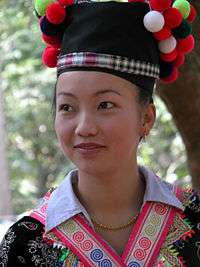
Specialists are largely in agreement as to the ethnolinguistic classification of the ethnic groups of Laos.[9] For the purposes of the 1995 census, the government of Laos recognized 149 ethnic groups within 47 main ethnicities.[9] whereas the Lao Front for National Construction (LFNC) recently revised the list to include 49 ethnicities consisting of over 160 ethnic groups.[9]
The term ethnic minorities is used by some to classify the non-Lao ethnic groups, while the term indigenous peoples is not used by the Lao PDR.[9] These 160 ethnic groups speak a total of 82 distinct living languages.[10]
Lao 53.2%, Khmu 11%, Hmong 9.2%, and other (over 100 minor ethnic groups) 26.6% (2015 census).[11]
| Ethnic group |
Language family |
census 1985[12] | census 1995[13] | census 2005[13] | census 2015[11] | ||||
|---|---|---|---|---|---|---|---|---|---|
| Number | % | Number | % | Number | % | Number | % | ||
| Lao | Tai-Kadai | 1,804,101 | 2,403,891 | 52.5 | 3,067,005 | 54.6 | 3,427,665 | 53.2 | |
| Khmu (Keummeu) | Mon-Khmer | 389,694 | 500,957 | 11.0 | 613,893 | 10.9 | 708,412 | 11.0 | |
| Hmong (Mong) | Hmong-Mien | 231,168 | 315,465 | 6.9 | 415,946 | 8.0 | 595,028 | 9.2 | |
| Thai (Tai) | Tai-Kadai | 1,459 | 215,254 | 3.8 | 201,576 | 3.1 | |||
| Thaineau | Tai-Kadai | 14,799 | 11,622 | ||||||
| Puthai (Phuthai or Phouthay) | Tai-Kadai | 441,497 | 472,458 | 10.3 | 187,391 | 3.3 | 218,108 | 3.4 | |
| Lü (Lue or Leu) | Tai-Kadai | 102,760 | 119,191 | 2.6 | 123,054 | 2.2 | 126,229 | 2.0 | |
| Katang | Mon-Khmer | 72,391 | 95,440 | 2.1 | 118,276 | 2.1 | 144,255 | 2.2 | |
| Makong (So) (Bru) | Mon-Khmer | 70,382 | 92,321 | 2.0 | 117,872 | 2.1 | 163,285 | 2.5 | |
| Akha (Kor) | Tibeto-Burman | 57,500 | 66,108 | 1.4 | 90,698 | 1.6 | 112,979 | 1.8 | |
| Yrou (Laven, Loven, Jru', Yuroo) | Mon-Khmer | 28,057 | 40,519 | 0.9 | 47,175 | 0.8 | 56,411 | 0.9 | |
| Xuay (Juk, Suai, Kui, Kuy, Suay, or Shuay) | Mon-Khmer | 49,059 | 45,498 | 1.0 | 42,834 | 0.8 | 46,592 | 0.7 | |
| Singsily (Phounoy) (Singsiri) | Tibeto-Burman | 23,618 | 35,635 | 0.8 | 37,447 | 0.7 | 39,192 | 0.6 | |
| Duon (Nhuon, Nghieu, San | 33,240 | ||||||||
| Taoey (Ta-oy) | Mon-Khmer | 24,577 | 30,876 | 0.7 | 32,177 | 0.6 | 45,991 | 0.7 | |
| Nguan (Nguồn, Ngoaun, Nguane, Nguan or Nguane) | Mon-Khmer | 988 | 29,442 | 0.5 | 27,779 | 0.4 | |||
| Iewmien (Yao, Ewmien, Mien, Ilmearn) | Hmong-Mien | 18,091 | 22,665 | 0.5 | 27,449 | 0.5 | 32,400 | 0.5 | |
| Phong | Mon-Khmer | 18,165 | 21,395 | 0.5 | 26,314 | 0.5 | 30,696 | 0.5 | |
| Brao (Larvae) | Mon-Khmer | 16,434 | 17,544 | 0.4 | 22,772 | 0.4 | 26,010 | 0.4 | |
| Katu | Mon-Khmer | 14,676 | 17,024 | 0.4 | 22,759 | 0.4 | 28,378 | 0.4 | |
| Oey (Oy or Oi) | Mon-Khmer | 11,194 | 14,947 | 0.3 | 22,458 | 0.4 | 23,513 | 0.4 | |
| Pray (Prai) | Mon-Khmer | 15,000 [10] | 0.3 | 21,922 | 0.4 | 28,732 | 0.4 | ||
| Lamed (Lamet) | Mon-Khmer | 14,355 | 16,740 | 0.3 | 19,827 | 0.4 | 22,383 | 0.3 | |
| Lahu (Musir, Mussor, Lahoo, or Lahou) | Tibeto-Burman | 9,200 | 8,702 | 0.2 | 15,238 | 0.3 | 19,187 | 0.3 | |
| Kriang (Griang, Grieng, Ngae, or Ngeh) | Mon-Khmer | 8,917 | 12,189 | 0.3 | 12,879 | 0.2 | 16,807 | 0.2 | |
| Hor (Haw, Ho, Hoa, Chin Haw, Yunnanese, Yunnanese Chinese, or Panthay) | Sino-Tibetan | 6,361 | 8,900 | 0.2 | 10,437 | 0.2 | 12,098 | 0.2 | |
| Xingmoon (Puoc, Sing Mun, Xinhmun, or Xingmoun) | Mon-Khmer | 2,164 | 5,834 | 0.1 | 8,565 | 0.2 | 9,874 | 0.2 | |
| Jeng (Cheng, Ceng, Chieng, Chenh, Jeng) | Mon-Khmer | 4,540 | 6,511 | 0.1 | 7,559 | 0.1 | 8,688 | 0.1 | |
| Nhaheun (Nyaheun, Nahoen, Nha Heun, Nha Hon, Nya Hoen, Ngahearn, Nhahem) | Mon-Khmer | 3,960 | 5,152 | 0.1 | 6,785 | 0.1 | 8,976 | 0.1 | |
| Kmer (Khmer, Kamer, Khome) | Mon-Khmer | 169 | 3,902 | 0.1 | 5,825 | 0.1 | 7,141 | 0.1 | |
| Toum (Tum, Hung) | Mon-Khmer | 2,042 | 2,510 | 0.05 | 4,458 | 0.08 | 3,632 | 0.05 | |
| Xaek (Saek or Sairk) | Tai-Kadai | 2,459 | 2,745 | 0.06 | 3,733 | 0.07 | 3,841 | 0.05 | |
| Samtao (Sam Tao) | Mon-Khmer | 2.359 | 2,213 | 0.05 | 3,533 | 0.06 | 3,417 | 0.05 | |
| Sila (Sida or Syla) | Tibeto-Burman | 1,538 | 1,772 | 0.04 | 2,939 | 0.05 | 3,151 | 0.05 | |
| Tri (Chali, Cali, or So Tri) | Mon-Khmer | 20,902 | 20,906 | 0.5 | 26,680 | 0.05 | 37,446 | 0.6 | |
| Harak (Alak, Alack, Hahak) | Mon-Khmer | 13,217 | 16,594 | 0.4 | 21,280 | 0.04 | 25,430 | 0.4 | |
| Bid (Bit) | Mon-Khmer | 1,530 | 1,509 | 0.03 | 1,691 | 0.03 | 2,372 | 0.04 | |
| Lolo (Alu) | Tibeto-Burman | 842 | 1,407 | 0.03 | 1,691 | 0.03 | 2,203 | 0.03 | |
| Pako (Pacoh) | Mon-Khmer | 12,923 | 13,224 | 0.3 | 16,750 | 0.03 | 22,640 | 0.4 | |
| Lavy (Lavi) | Mon-Khmer | 584 | 538 | 0.01 | 1,193 | 0.02 | 1,215 | 0.02 | |
| Yae (Jeh, Gie, Yerh) | Mon-Khmer | 3,376 | 8,013 | 0.2 | 10,570 | 0.02 | 11,452 | 0.2 | |
| Sadang (Sedang, Sdang, Gayong) | Mon-Khmer | 520 | 786 | 0.02 | 938 | 0.02 | 898 | 0.01 | |
| Hanyi (Hayi or Hayee) | Tibeto-Burman | 727 | 1,122 | 0.02 | 848 | 0.02 | 741 | 0.01 | |
| Guan (Kuan or Tai Guan) | Tai-Kadai | 722 | 0.01 | 886 | 0.01 | ||||
| Oedou (Ơ Đu, Adoo) | Mon-Khmer | 649 | 0.01 | 602 | 0.01 | ||||
| Yang (Giay, Nhang, Dang, or Niang) | Tai-Kadai | 4,630 | 0.1 | 616 | 0.01 | 5,843 | 0.1 | ||
| Moy | 534 | 0.01 | 789 | 0.01 | |||||
| Thin (Mal, Htin, or Thein) | Mon-Khmer | 13,977 | 23,193 | 0.51 | 514 | 0.01 | |||
| Kree (Kri) | Mon-Khmer | 110 | 739 | 0.02 | 495 | 0.01 | 1,067 | 0.02 | |
| Trieng (Talieng, Tariang, Caliang, or Treang) | Mon-Khmer | 23,665 | 23,091 | 0.5 | 29,134 | 0.5 | 38,407 | 0.6 | |
| Kui (Yellow Lahu) | Tibeto-Burman | 6,493 | 6,268 | 0.1 | |||||
| Khir | 1,639 | 0.04 | |||||||
| Numbri (Yumbri, Mlabri, or Yhumbri) | Mon-Khmer | 67 | |||||||
| Yung | 6,160 | ||||||||
| Thaen | 828 | 0.01 | |||||||
| Mone (Meuang or Mon) | 2,022 | 217 | 0.00 | ||||||
| Vietnamese | 12,086 | ||||||||
| Chinese | 2,624 | ||||||||
| Thai | 1,459 | ||||||||
| Cambodian | 274 | ||||||||
| Burmese | 185 | ||||||||
| Indian | 44 | ||||||||
| French | 13 | ||||||||
| Others & not stated | 11,277 | 19,285 | 0.4 | 67,175 | 1.2 | ||||
| Total | 3,584,803 | 4,574,848 | 5,621,982 | 6,446,690 | |||||
CIA World Factbook demographic statistics
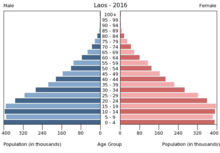
The following demographic statistics are from the CIA World Factbook, unless otherwise indicated.
Sex ratio:
at birth: 1.1 male(s)/female
under 15 years: 1.01 male(s)/female
15-64 years: 0.98 male(s)/female
65 years and over: 0.76 male(s)/female
total population: 0.98 male(s)/female (2009 est.)
Life expectancy at birth:
total population: 62.39 years (2011 est.)
male: 60.50 years (2011 est.)
female: 64.36 years (2011 est.)
Nationality:
noun: Lao(s) or Laotian(s)
adjective: Lao or Laotian
Religions: Buddhist 67%, Christian 1.5%, other and unspecified 31.5% (see Religion in Laos)
Languages: Lao (official), French, English, Vietnamese, and various ethnic languages
Literacy:
definition: age 15 and over can read and write
total population: 73%
male: 83%
female: 63% (2005 est.)
See also
References
- "Population Census 2005". Archived from the original on 2010-11-14. Retrieved 2010-12-13.
- ""World Population prospects – Population division"". population.un.org. United Nations Department of Economic and Social Affairs, Population Division. Retrieved November 9, 2019.
- ""Overall total population" – World Population Prospects: The 2019 Revision" (xslx). population.un.org (custom data acquired via website). United Nations Department of Economic and Social Affairs, Population Division. Retrieved November 9, 2019.
- "Demographic and Social Statistics". Unstats.un.org.
- Population Division of the Department of Economic and Social Affairs of the United Nations Secretariat, World Population Prospects: The 2010 Revision
- "Lao Social Indicator Survey 2011-12". Lao Statistics Bureau. 1 December 2012.
- Lao People's Democratic Republic Special, 2011-12 - Lao Social Indicator Survey (MICS/DHS) Final Report (English)
- "World Population Prospects – Population Division – United Nations". Retrieved 2017-07-15.
- Indigenous Peoples Development Planning Document
- Ethnologue report for Laos
- "Results of Population and Housing Census 2015" (PDF). Lao Statistics Bureau. Retrieved 1 May 2020.
- Schliesinger, Joachim. White Lotus Press. Bangkok. 2003
- UN Demographic Yearbooks
